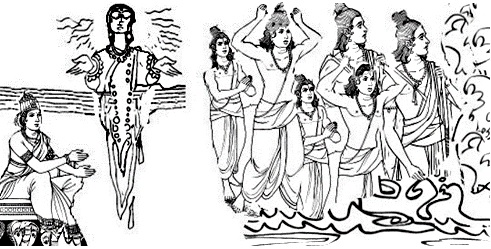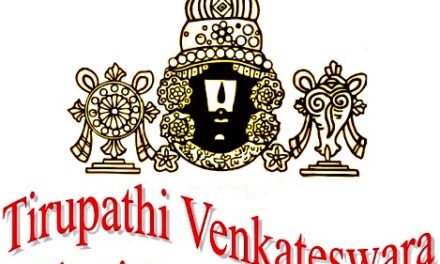
– Santhipriya –
Sita Banished, Kingdom restored and Lava-Kusha born
Even in the midst of mire controversies here and there, Rama’s land continued to expand in territories. Then one day came sage Agasthiya to counsel Rama to go for a horse sacrifice called Ashwametha Yahya to grace his folks and appease omens. Thereafter Rama let loose a horse for the great horse-sacrifice as mark of commencing the ceremony with extraordinary splendor, and showered choicest gifts and alms to the invitees who came from all directions. Lava Kusa dwelling in hermit Valmiki’s place held with them the sacrificial horse let loose by Rama after commencement of the ceremony.
As per the text book rules of Vedic rites, as and when the solemn horse sacrifice commenced, the monarchs used to let loose a mighty horse to travel through the territories ruled by Royals of different races. Allowing the horse to run free and unhindered in their land shall be the symbolic gesture of the royals for accepting the supremacy of the master of Yahya, and subsequently become subordinate royals to the performer. Those wish to defy dominance of the performer, block the free passage of the horse in their land to send the message ‘Let my flag flutter in my land, or you become my lord after conquering me’. The sacrifice horse thus dispatched by Rama, contained by the twins- Lava and Kusa, and held captive in hermit Valmiki’s ashram reached Rama’s ears and a wonder struck Rama inquired from the saintly sage through feelers as to who the twins were. The sage would not reveal the identity of the boys to the feelers, but promised to tear the mask once they render Ramayana in Rama’s court at the end of the Yahya, till which time Rama need to restraint self and remain calm.
Thereafter sage Valmiki dispatched Lava and Kusa to the solemn sacrifice site when it began, and the boys stirred the souls of the audience present there with their soft voice and unwinking eyes. At the end Rama learnt from the teacher that the twins were trained by the sage. Unable to anymore abate his thirst, his brothers following, Rama met the sage in his dwelling, fell at his feet and pleaded for lifting the veil of secrecy of the twin boys, the sage broke all facts to reveal that the twins were none other but Rama’s heir only, born to Sita. Rejoiced Rama pledged his faith on Sita and requested the saint to convince Sita to return, but at the counseling of the sage, Rama decided to hold Sita’s hand in public once she wiped out the slander by proving her modesty in public at the end of the Yagna itself till which time her visit shall remain a secret. However since the presence of spouse is essential for performing any sacrifice, Rama had no choice but to keep a puppet of Sita as her presence by his side till the sacrifice concluded.
When the sacrifice concluded, sage Valmiki petitioned Sita and produced before folks and addressed ‘Sita, time has come to wipe out the mud on you. Now in front of the audience establish that none but Rama alone was your breath, thought, deed, spirit and feeling even while in solitary confinement at Ravana’s dwelling……daughter, establish to the world that the sacred truth that your modesty is nothing but pure fire’.
Waiting for such an occasion, pious and pure Sita asked them to raise a huge pyre and in front of all solemnly prayed to earth ‘Fostering God of earth, my mother, hold me into you if I am as pure as fire, stainless and unsullied wife’. To the bewilderment and shock of assembly, a chasm opened in earth that appeared in glorious form, fire burning above, earth Goddess called Boomadevi, came through the fire and clasped her pure daughter to her breast, and vanished inside, doors of earth closed again.
The unexpected tremor enraged Rama who angrily and quickly pulled out his sword shouting for the return of his pure spouse lest, the mother earth shall be doomed. In time, lord Brahma appeared before Rama and restrained him to remain calm as countdown to end his incarnation along with his brothers have begun as their tasks in earth have been fully accomplished in that incarnation, thereby signifying the divinely status of Rama la Lord Vishnu to the audience and the world. Sita has been embraced back by mother earth who gave her to Dasaratha. Sacrificial rites thus ended with reunion of short lived divorcees, Rama was counseled to conclude the ceremony with parting noble gifts and alms to the assembly. Brahma’s advice heeded in words and spirit, Rama honored the assembly in the perfect manner and downed the curtain bading goodbye to all.
There is another important message that needs to be addressed here. When the virtual image of Goddess Sita was created and sent, it became necessary that the virtual image carried within herself some of the feelings and mannerisms of Goddess Sita, lest Ravana would easily detect that the virtual image was not that of Sita Devi. Immediately on the annihilation of Ravana, only the original Sita Devi gets reunited with Lord Rama. Seconds before the drama, she absorbs the virtual image -Vedavati- sitting under the Ashoka Vana in Sri Lanka and sits there in person (real Sita Devi) to get rescued by her husband Rama. Therefore only the real form of Sita Devi and not Vedavati who was the virtual image, joined with Lord Rama. Since the time was not ripe to reveal in public either the true aspects of Vedavati or the reasons for her creation, Sita Devi maintained silence and waited till the drama entering into the fire to prove her modesty was enacted in the midst of which she came out from the fire along with her virtual image –Vedavati- to reveal the entire truth after which Vedavati disappeared. The act of disappearance of Vedavati is only the philosophy of merging into the body of Sita.
Similarly the act and drama of Sita Devi reuniting with Lord Rama and entering into the fire did not happen immediately upon annihilation of Ravana. It takes place only after her twin sons Lav-kusa were born. For want of huge space, the detailed narrations after she gets reunited with Lord Rama has been skipped since they were all familiar stories and everyone understands them.
Back to Kalidasa’s story, sullied Rama lost his balance and on the counsel of sage Yathaajit, he transferred to Bharatha, his brother entire land of Sindhu, who too ruled it only for short while before bidding farewell to the rule and to position his sons Thakkan and Purlakan on Royal chair. Similar history followed with another brother Lakhman who too parted with the Kingship to throne Anghada and Chandrakethu his two sons. Not to be left behind, Rama too followed their steps to engage his twins Lava and Kusa in the ruling.
Thus Raghu brothers peacefully passed on their burden to their due and perfect successors to lead an austere life, and when the time to reach their lords in heaven came, the torch bearer in the form of sage Durvasa visited Rama. He desired one to one secret conference with Rama which when granted, met him in isolation and persuaded Rama to end his incarnation. Lashman, who stood guard at the gate broke in upon hearing their secret conversation in a haste as he staggered to hear the content and turned sad. To atone the sin of committing entry in to the secret meeting room as uninvited guest, and the fact on Rama’s end heard, sad Lashman sought their pardon and in deep devotion and love to Rama quietly walked to river Sarayu in isolation and shed his earthly venture in yogic style. The soul within his body flew to heaven.
With one quarter of his earthly essence in the form of Lashman gone, who was not less than a twins though not born twins, and unable to bear his loss, Rama realized in all firmness that the time to shed the body too has ripened. Quickly he placed Lava and Kusa in firm saddle of the realm assigning the duties and one day marched to river Sarayu followed by his steadfast-souled brothers – Bharatha, Sathrughna and others and mounted up to heaven entering into the river. Thus though ended the incarnation of Rama and other brothers after their task to slain the foes of Boologa (Earth) were accomplished, their lineage continued with Lava, Kusa and other sons of the faded incarnates.
———————
Brief commentary:-
One of the books, Valmiki Ramayana translated into Tamil, written in the year 1941 by an eminent author called ‘Maha Vidwan Sreemath Prathivathi Bayangaram Annangarachariya Swamigal’ of Kanjeepuram district of Tamilnadu in India has mentioned under title ‘Samshaeba Ramayana’ in the first Sarga of the book that it was Sage Narada who briefed the epic Ramayana to Valmiki and thereafter, an incident that occurred in the bank of river Tamasa provoked Valmiki and prompted him to compose the Ramayana in verse form. As he was searching for suitable disciple to pass on the gem, Lava and Kusa came forward to absorb the epic.
The said Ramayana, in the form of verse portraying the valor of Rama has been reportedly composed during the rein of Rama and therefore Lava and Kusa were able to recite them in Rama’s court. However the epic in verse did not attempt to promote Rama a divine incarnate, though the events and narration linked the folks on earth and those in heaven.
The Valmiki Ramayana in original reportedly consisted of 24,000 poems (paras of Verses) spread over seven cantos, narrations covering from Rama’s birth to his crowning ceremony. However the mute question that remains unanswered has been whether Ramayana reportedly recited by Lava and Kusa in Rama’s court, foretold the events leading to ultimate fading away of Rama and Sita? The scholars are of the view that the verse composed by Valmiki as we have today is certainly incomplete. Tradition, as narrated in word of mouth stories say that while it is true that the Valmiki Ramayana in its original form consisted of 24,000 versus many of which have only come down to us, but the abrupt end of the verse with Rama ascending the throne confirms the belief that many pertaining to i.e. Rama’s lineage prior to his birth and after his demise may have been lost but mysteriously the same has been narrated by Kalidasa in the epic he composed much after Valmiki lived. When Kalidasa was able to narrate Raghu’s line before and after Rama’s birth and shedding of incarnation, how could Valmiki not know about them? Moreover, Kalidasa’s Raghuvamsam mentions the recital of Ramayana by Lava and Kusa and therefore one cannot brush aside the belief that perhaps Kalidasa could have read Valmiki Ramayana in full based on which his epic may have been composed and that the Valmiki Ramayana in original would have also contained the pre and post Rama clan but may have been only known to Kalidasa through Valmiki Ramayana in original.
continued /13


